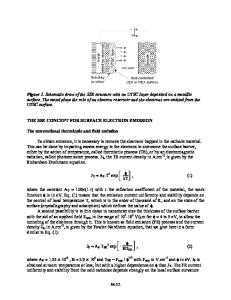Observation of Hot Electron Field Emission
- PDF / 236,991 Bytes
- 6 Pages / 612 x 792 pts (letter) Page_size
- 30 Downloads / 302 Views
Observation of Hot Electron Field Emission Jonathan Shaw Code 6844, Naval Research Laboratory Washington DC 20375 ABSTRACT We report energy distributions of silicon Field Emitter Arrays coated with 50A of ZnO. The distributions reflect changes in the ZnO conductivity induced by annealing in vacuum, temperature, and annealing in hydrogen. An additional coating of titanium performed in-situ produced large additional changes. Emission from the ZnO at energies near the Fermi level increased with gate voltage only after hydrogen annealing, when hot, and after Ti coating. In those same cases the emission distribution contained a tail at energies above EF. The highenergy emission tail is due to a many-body or Auger process whereby holes injected below EF create hot electrons. Although emission from ZnO occurred at energies up to 8eV below EF, no high-energy tail was observed in the normal case. Thus emission appears to occur from isolated electrons in ZnO gap states in cases where the distribution lacks a high-energy tail. Conversely, emission above EF suggests that emission occurred from a metallic state such as an accumulated conduction band. INTRODUCTION The field emission energy distribution is helpful in understanding field emission physics [1], a process that remains poorly understood for general surfaces (other than atomically clean metals). Unlike clean metal surfaces, field emission from both molybdenum and silicon field emitter arrays often occurs at energies several volts below EF [2,3]. The low energy emission is related to the presence of the native oxide and the density and energy distribution of states at the interface and in the oxide [4]. A single charge near the emission site can make a big change in the emission current and energy. The density of states in the oxide appears to be increased by both emission and baking in UHV. However, the density of states can be reduced again by exposing the surface to oxidizing species and/or cooling the surface to room temperature. Thus improved performance might be achieved by coating the surface with a conductive material relatively immune to oxidation. A number of metal oxide semiconductors are typically conductive due to native defects, and a prime example is ZnO. Although ZnO is a wide band gap semiconductor (Eg=3.3eV), it is typically n-type when it is slightly oxygen deficient. Several dopants including noble metals can increase the conductivity. EXPERIMENT The field emitter arrays were fabricated from n-type (0.02 ohm-cm) single-crystal silicon at MCNC. The fabrication process made use of oxidation sharpening and “tip-on-post” geometry as reported previously [5]. The gate aperture diameter was about 1.5μm, the gate metal was 0.5μm thick Pt, the tip height was about 2μm, and the tip pitch was 4um. The tip apex radii of similarly prepared specimens were about 5nm. The data reported here were obtained from an array patterned with 37530 tips. Several other arrays on the same die produced similar results. A 50Å layer of ZnO was deposited by sputtering. The ZnO-coated
Data Loading...










